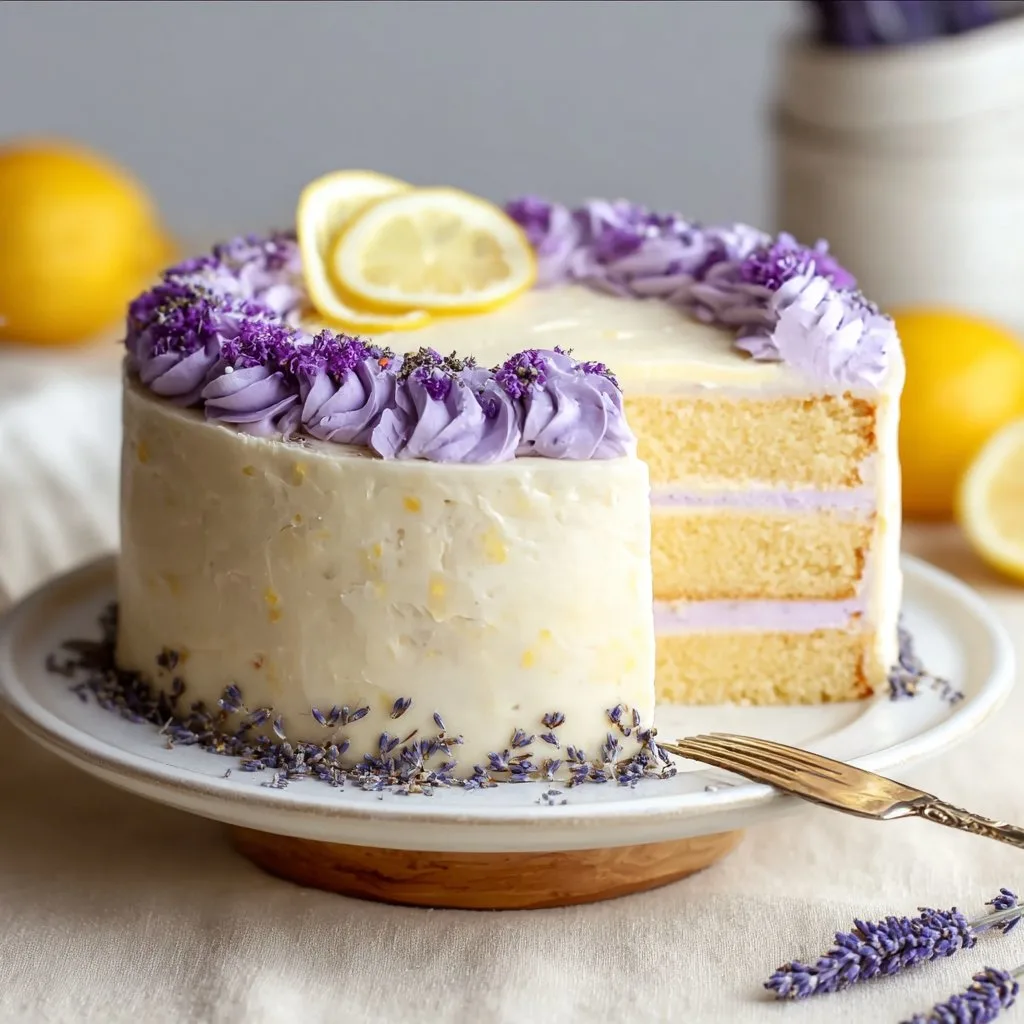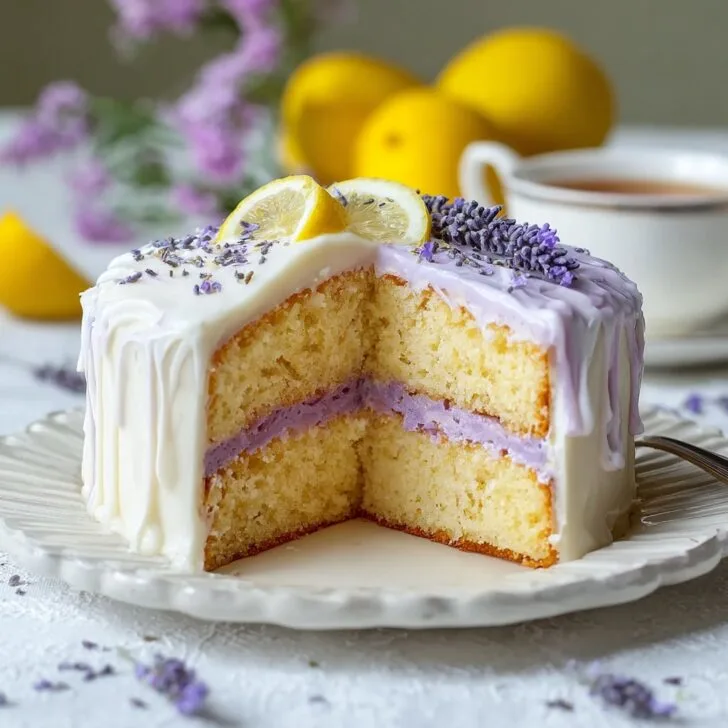If you could smell my kitchen right now, you’d swear the windows were open and there was a little seaside breeze wafting in. I baked this lemon lavender cake for a spring brunch a while back, and my neighbor wandered in “just to return a cup of sugar” and somehow left with two slices tucked in a napkin. Fair play. The scent is like walking past a garden after rain, and the crumb is so tender it feels like a polite handshake. I did once spill lavender buds everywhere and the cat looked personally offended, but we’ve moved on.
Why I keep making this
I pull this out when the week feels grey or when we have an afternoon tea thing going on. My family goes a bit mad for it because it tastes bright without being shouty, and the glaze gives that shiny finish that makes you look like you tried harder than you did. I used to struggle with the batter looking curdled when the lemon hit the dairy; actually, I find it works better if everything is at room temp and I alternate the flour with the yogurt. Also, the lavender is gentle here, not perfumey, which is my big fear with floral bakes. And if you’ve ever thought, hmm, can cake taste like a sunny day, well, here we are.
Ingredients you’ll need and a few easy swaps
- 190 g all purpose flour about 1 and ½ cups (my gran swore by Brand X, but honestly any decent flour works fine)
- 1 and ½ teaspoon baking powder
- ¼ teaspoon baking soda
- ½ teaspoon fine sea salt
- 1 to 1 and ½ teaspoon culinary lavender buds lightly crushed (go easy at first; you can add more next time)
- 200 g granulated sugar about 1 cup
- Zest of 2 fresh lemons (rub it into the sugar for extra oomph)
- 115 g unsalted butter softened about ½ cup (or use 100 ml neutral oil when I’m in a rush and don’t want to cream butter)
- 2 large eggs at room temp
- 180 g full fat Greek yogurt about ¾ cup, or sour cream; buttermilk works too
- 2 tablespoon fresh lemon juice
- 1 teaspoon vanilla extract
Optional lemon syrup for extra moisture
- 2 tablespoon lemon juice
- 2 tablespoon sugar
- 1 tablespoon water
Simple glaze
- 120 g powdered sugar about 1 cup
- 1 to 2 tablespoon lemon juice, plus a splash of milk or cream if you like it softer
- A pinch of lavender buds or lemon zest for sprinkling, optional
Swaps I actually use
- I sometimes use half olive oil and half butter for a fruitier vibe.
- No Greek yogurt in the fridge Use ¾ cup milk plus 2 teaspoon lemon juice and let it sit 5 minutes. Or check a proper buttermilk swap here: buttermilk substitute.
- If your lavender is punchy, start with 1 teaspoon and see how you feel. Culinary grade only, please.
Step by step, but not too fussy
- Heat the oven to 350 F or 175 C. Grease and line an 8 inch round pan with parchment. A 9 by 5 loaf pan works too, though the bake time stretches a bit.
- Make lemon lavender sugar. In a bowl, add the sugar, lemon zest, and lavender. Use your fingers to rub them together until it smells like a good day. This is where I usually sneak a tiny taste.
- Cream the butter with that fragrant sugar until pale and fluffy, about 2 to 3 minutes. Hand mixer is grand here. If using oil, just whisk the sugar with the eggs well until thick and glossy.
- Beat in the eggs one at a time. Add the vanilla. If it looks a little separated, don’t panic.
- Whisk the flour, baking powder, baking soda, and salt in a separate bowl.
- In a cup, stir the yogurt with the lemon juice to loosen it. It might look a bit weird at this stage; it always does.
- Add a third of the flour to the bowl, then half the yogurt, then flour, then the rest of the yogurt, finishing with flour. Mix gently just until you can’t see streaks. I once overmixed and the cake got a tad tough, so easy does it.
- Scrape the batter into the pan and level it. Bang the pan once on the counter for good luck.
- Bake on the center rack until the top is golden and springs back lightly, 35 to 42 minutes for the round pan. A loaf pan can take 50 to 60. A skewer should come out with a crumb or two, not wet batter.
- While it bakes, simmer the lemon syrup ingredients for 2 minutes and set aside.
- Cool the cake in the pan for 10 minutes. Poke gentle holes with a skewer and brush on the warm syrup. Let it cool completely on a rack before glazing. I tried glazing warm cake once, and it slid right off like a tiny sugar avalanche.
- Whisk the glaze to a pourable consistency and drizzle over the cool cake. Add a flutter of zest or a whisper of lavender on top if you fancy.
On second thought, if you only have a square 8 inch pan, that’s fine too. The corners get a bit chewier, which I kind of love.
Notes from my messy kitchen
- Lavender strength varies wildly. If you’re nervous, steep 1 teaspoon buds in the lemon juice for 10 minutes, strain, and use the infused juice only.
- Resting the batter for 5 minutes before baking seems to let the flour hydrate; I get a more even rise.
- A little salt in the glaze keeps it from tasting flat. Just a few grains.
- If you want to understand zesting technique, this is a clear primer: how to zest a lemon.
Variations I’ve tried
- Blueberry lemon lavender: fold in 1 cup fresh blueberries tossed in a spoon of flour. Lovely pop of fruit.
- Honey kissed: swap 3 tablespoon of the sugar for runny honey. The crumb gets a bit more tender, and the flavor hums.
- Cupcake situation: bake in a muffin tin, about 18 to 20 minutes. Cute for showers.
- The one that didn’t quite work: I once tried swapping half the flour for almond flour and, well, it sunk in the middle and turned into a puddingish slice. Tasty with yogurt though.
Equipment I use
- 8 inch round cake pan and parchment. I call lining essential, then inevitably I forget sometimes and regret it.
- Microplane zester for the lemons. No zester Use a vegetable peeler, then chop the strips teeny tiny.
- Hand mixer for creaming. Or a whisk and some elbow grease if that’s what you’ve got.
- Mortar and pestle for lightly crushing lavender, but a small bag and a rolling pin work in a pinch.
Minor detour: if you grow lavender, make sure it’s the culinary sort. Not all garden lavender tastes nice. Here’s a helpful read on using lavender in food: cooking with lavender.

How to store it without it disappearing
Keep the cake in an airtight tin at room temp for up to 2 days. Refrigerate for 4 to 5 if you must, just let slices come to room temp before serving. Freeze wrapped slices for up to 2 months, then thaw on the counter. Though honestly, in my house it never lasts more than a day. I blink and there’s a mysterious wedge missing.
Serving it
I like a cheeky slice with hot tea in the late afternoon. For brunch, add a cloud of lightly sweetened whipped cream and a handful of berries. My small family tradition is to light a candle and call it a birthday breakfast cake, which feels slightly rebellious and very right.
Pro tips I learned the wonky way
- I once tried rushing the cooling step and regretted it because the glaze just pooled and the top tore when I moved it.
- Overmixing is sneaky; stop as soon as the flour disappears. I know, it’s tempting to keep going.
- Measure flour by weight if you can. If not, fluff, spoon, and level. The cake forgives a little, but not a mountain of flour.
- Too much lavender equals soap vibes. Start small. It’s crumb is delicate, and you want balance.
FAQ you’ve actually asked me
Can I use lavender from my garden
Maybe. It needs to be culinary grade, clean, and not sprayed. If you’re unsure, buy culinary lavender. It’s inexpensive and reliable.
Can I make this dairy free
Yes. Use a neutral oil instead of butter and a dairy free yogurt or milk mixed with a little lemon juice. Texture stays soft, flavor still bright.
What if the batter looks curdled
It happens when lemon meets dairy. Keep going, add the dry ingredients, and it will come together in the oven. Promise.
Oil or butter, which is better
Butter gives that classic cake flavor. Oil gives extra moisture and keeps it soft even when cold. I tend to think half and half is a sweet spot.
Which pan works best
My default is an 8 inch round. A loaf pan is cozy and sliceable. A small bundt is pretty but grease it well. I said a mixer was essential earlier, but you can whisk by hand here if you feel up for it.
Can I reduce the sugar
A little. Drop 2 to 3 tablespoon and you’ll be fine. Much more and the texture changes. Or skip the glaze and keep the cake as is.
How do I make buttermilk if I dont have it
Stir 1 tablespoon lemon juice into 1 cup milk and let it sit 5 to 10 minutes. Or see the buttermilk link above for more details and tips.
Do I need to grind the lavender
I like to lightly crush it so you don’t get big bits. Rubbing it into the sugar with the zest helps release flavor gently.
Last tiny note before I forget: when you pour the batter, don’t be like me and pour it form the bowl onto the counter. That was a day.

